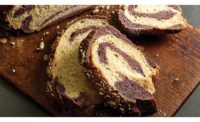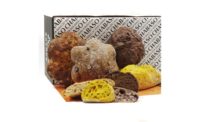Bakers seek new bread ideas, seasonal flavors

courtesy of Innovative Bakery Resources/Ardent Mills

courtesy of Innovative Bakery Resources/Ardent Mills


Baking bread is a balancing act, and any change in ingredients and technique can shift the outcome of a loaf in ways that affect flavor, volume and structure. This balance is always top of mind when we approach a new formulation for a high-inclusion bread, like cinnamon-raisin swirl or multigrain, at Innovative Bakery Resources (IBR), Tualatin, OR, a division of Ardent Mills. Incorporating whole grains and seeds in combination can create unique flavors and textures and a rustic, artisanal aesthetic. However, there are many factors to think through when formulating with high levels of grains or seeds. Two very important aspects to consider are flavor and structure.
Adding and subtracting
Higher levels of grains and seeds will dilute salt and sweeteners, so the formulation requires supplementing these levels to achieve a desired flavor profile or prevent the bread from tasting bland. Also, the addition of higher levels of grains or seeds can weaken the overall bread structure. More dough strengtheners or gluten may need to be added to achieve the desired product height.
Understanding how grains and seeds function in a product happens mostly through trial and error. The baker must understand the desired goal concerning flavor, texture and overall appearance. Some inclusions—like sesame seeds and small, light grains—disappear during mixing or processing. Other inclusions—chopped or whole kernels—require additional steps to soften or hydrate the grains before they are added to the dough. To simplify the prep work, bakers can try individually quick-frozen (IQF) grains that don’t require precooking or hydrating.
Seeds, nuts and grains are generally added for texture, flavor or nutritional enhancement. Most grains and seeds have no added benefit to the structural integrity of a loaf of bread, but we need to do a lot of experimentation to ensure that these ingredients don’t take away from the loaf’s integrity. The higher percentage of inclusions to flour weight or a finer granulation size will cause bread to lose volume and become increasingly dense. Also, certain grains or seeds in finely ground form can cause bitterness or “off” flavors in bread. To maintain a lighter texture and superior flavor, it is necessary to have a balanced formula. Increasing your dough-to-pan ratio will help maintain bread volume without dramatic increases to dough strengtheners or gluten.
Fighting gravity
Volume and loaf integrity can be even trickier when making swirled breads. Consistency is always the challenge. The goal is to get the same amount of filling and swirls in every loaf. But, unfortunately, gravity and other variables in the production process lead to inconsistencies. Having the right equipment and some type of water spray before the swirl is added is key to a consistent swirl every time. At IBR, we use a method of adding flavored filling to the dough in slurry form. A gentle, low speed on the spiral mixer allows for good incorporation and even distribution of filling.
Water is also essential when adding ingredients to the outside of the loaf, or enrobing. A simple pan of water to wet the dough piece is a big help when rolling the dough piece in seeds. When scaling up, bakers often rely on a deco seeder to enrobe products. A deco seeder is a production unit that sprays water on the dough piece as it moves down the belt. A separate hopper above introduces seeds to the dough piece, and then the enrobing is pressed firmly into the dough under a pressure board. Most deco seeders optimize efficiency because of the machines’ ability to recycle seeds back to the main seed hopper.
As new ingredients emerge or older ingredients come back into fashion, we rely on traditional trial and error to introduce them to our processes. Right now, we are working with a quinoa crisp and some other puffed grains. They add a really distinctive aroma, texture and flavor to the crust of the bread that you can’t get with other grains. We are also testing some flaked grains that are unique as toppings, like blue and black barley. Flaked barley has the approximate shape and size of oats and adds subtle color to loaves.
Seasonal specials
Seasonal bread loaves have become increasingly popular. Ideas for new flavors can come from anywhere. Typically, a customer request or a current trend drives our development process. There are also instances when employee opinions shape the development of something completely out-of-the-box new. So far, we’ve tried to stick to mainstream, familiar flavors for our seasonal varieties. Pumpkin Spice bread and Apple Strudel bread are popular in the fall. Varieties marketed for spring and summer include Peach Cobbler and Lemon Crème. After the concept is established, IBR goes to work on putting together our list of flavors.
Many of our flavors are based on popular pastry or snack items, and it’s been effective to utilize these flavors and textures and incorporate them into the convenience of a loaf of bread. For example, S’mores and Lemon Crème breads are two dessert-influenced loaf breads that have been hits for us. Bread has many advantages over pastries. For instance, it’s easy to warm up or toast bread in a toaster. Additionally, serving size and nutritional information are more understandable, and it’s a better value economically. Some foodservice clients even use our loaves in popular menu items, like seasonal French toast specials.
The great thing about having a creative research and development facility dedicated to baking is that we can move beyond the challenging ideas that can derail most bakers. Customized products that include swirls, specialized mixes and a hands-on approach allow us to be unique while still efficiently managing production. Creating specialized products with an artisan feel is at IBR’s core.
Looking for a reprint of this article?
From high-res PDFs to custom plaques, order your copy today!









